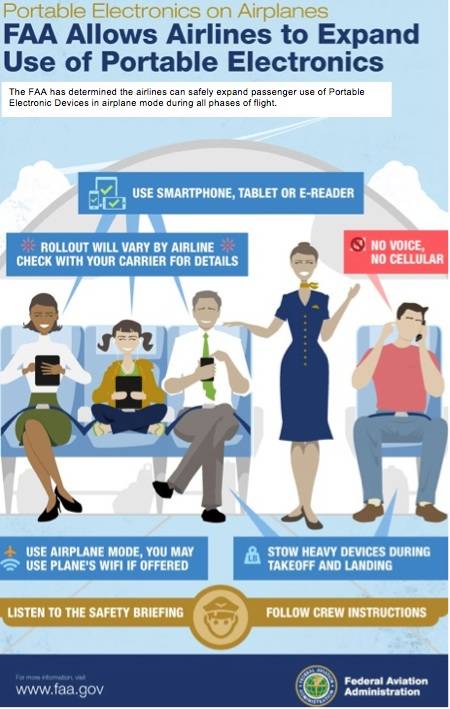Regulations regarding the use of portable electronic devices during flights will be eased, the FAA (Federal Aviation Authority) announced today.
Passengers will be allowed to use e-books, video devices, as well as play games throughout the whole trip, with very limited exceptions.
The FAA, which is part of the US Department of Transportation, says it is sending implementation guidance regarding the usage of portable electronic devices during flights to airlines immediately.
As not all fleets and operations are the same, the implementation will vary from airline-to-airline.
However, the FAA is fairly sure they will all “prove to the FAA that their planes allow passengers to safely use their devices in airplane mode, gate-to-gate, by the end of the year.”
Before making its decision, the FAA says it gathered data and input from the mobile technology industry, flight attendants, pilots, passengers, airlines and airplane manufacturers.
Magazines, books and electronic devices need to be held or place in the seat back pocket during landing and takeoff.
Rules on portable electronic devices during flights exclude cell phones
Cell phones should have no signal bars displayed (either disabled or in airplane mode) during landing and takeoff “and cannot be used for voice communications based on FCC regulations that prohibit any airborne calls using cell phones.”
Wireless keyboards and other Bluetooth accessories can be used throughout the flight. If the airline provides WI-FI, this can also be used during the whole flight.
Transportation Secretary Anthony Foxx, said:
“We believe today’s decision honors both our commitment to safety and consumer’s increasing desire to use their electronic devices during all phases of their flights. These guidelines reflect input from passengers, pilots, manufacturers, and flight attendants, and I look forward to seeing airlines implement these much anticipated guidelines in the near future.”
FAA Administrator Michael Huerta said “I commend the dedication and excellent work of all the experts who spent the past year working together to give us a solid report so we can now move forward with a safety-based decision on when passengers can use PEDs on airplanes.”
Most planes tolerate portable electronic devices during flights
The Portable Electronic Devices Rulemaking Committee (the Committee) concluded that the majority of planes could tolerate radio interference signals from portable electronic devices (PEDs).
The Committee advised in a recent report that the FAA provide airlines with new procedures to determine whether their aircraft could tolerate radio interference from portable electronic devices.
As soon as an airline has determined what its fleet can safely tolerate, it will then allow passengers to use lightweight electronic devices, such as smartphones, e-readers and tablets at any altitude.
If visibility is low the crew will ask passengers to switch off their devices during landing. During takeoff and landing heavier devices should be stowed away in overhead bins or under seats, the Committee also recommended.
By providing updated and clear guidance, the FAA says it is streamlining the approval of usage of portable electronic devices in airplanes.
FAA eases rules on portable electronic devices during flights.
Using cell phone for voice communications, FCC jurisdiction
Whether and when passengers may use their cell phones for voice communications during a flight is the responsibility of the FCC (Federal Communications Commission), the FAA explained. That is why it did not consider the issue.
The Committee advised the FAA to consult with the FCC to review its current regulations. Cell phones, unlike other portable electronic devices, are designed to send out powerful signals so that they may be received at great distances.


